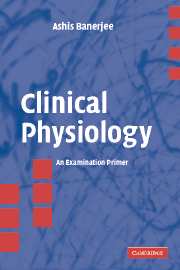6 - Cardiovascular System
Published online by Cambridge University Press: 05 June 2016
Summary
Introduction
The cardiovascular system comprises:
• A pump: the heart, which comprises two atria (reservoirs for blood and booster pumps to augment ventricular filling) and two ventricles (pumps). It consists of two pumps in parallel, with synchronised actions.
• A high pressure distribution circuit: the elastic arteries, i.e.the aorta and its major branches, serve a transport function. The muscular arteries serve a distributive function.
• Exchange vessels: the capillaries, which are 8–10 m in diameter. Capillaries can possess either continuous endothelium (muscle, heart, liver), fenestrated endothelium (gastrointestinal tract, renal glomeruli), or discontinuous endothelium (liver, spleen).
• A low pressure collection and return circuit.
The system allows rapid transport of oxygen, nutrients, hormones and waste products throughout the body. The structure of the components is related to function across the vascular tree.
The fetal circulation
This has the following characteristics:
• The right and left ventricles function in parallel;
• The placenta provides for gas and metabolite exchange;
• The parallel circulation is maintained by shunts at the ductus venosus, foramen ovale and the ductus arteriosus.
• Oxygenated blood flows from the placenta via the ductus venosus and inferior vena cava into the right atrium, where it is deflected by the crista dividens and the eustachian valve across the foramen ovale into the left atrium and thence into the left ventricle. It is then ejected into the ascending aorta.
• Deoxygenated blood from the superior vena cava flows into the right atrium, being primarily directed into the right ventricle and ejected into the pulmonary artery.
• Mixing of the venous returns occurs.
• The pulmonary circulation is a high-impedance and low-flow system.
• The placental circulation is a low-impedance and high-flow system
At birth, a transitional circulation ensues, with the following changes:
A reduction in pulmonary vascular resistance secondary to expansion of the lungs and an increase in arterial pO2.
An increase in systemic vascular resistance caused by removal of the low resistance placental circulation.
The systemic vascular resistance exceeds the pulmonary vascular resistance. A left-to-right shunt through the ductus arteriosus, with progressive closure. Functional closure of the foramen ovale as a result of raised left atrial pressure and volume.
Closure of the ductus venosus as a result of removal of the placenta from the circulation.
- Type
- Chapter
- Information
- Clinical PhysiologyAn Examination Primer, pp. 71 - 114Publisher: Cambridge University PressPrint publication year: 2005



